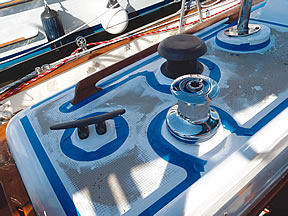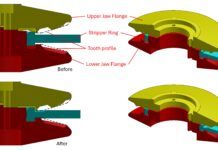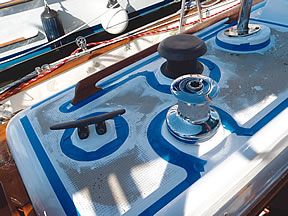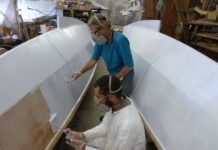Photos by Frank Lanier

Regarding your blog post on restoring gelcoat (posted online March 18, 2014): Ive seen many similar articles over the years directed toward refinishing topsides. However, Ive seen no discussion about restoring decks. I have an 18-year-old boat, and Im beginning to see pinholes in the deck gelcoat, particularly on edges and curves where I suspect the gelcoat is thinner. Im curious what the experts would recommend.
Is there an option to fill pinholes and compound over? Repainting is an option, but a very expensive one. On my previous 36-foot ketch, I was quoted $32,000 for a professional deck repainting (including all hardware removal and re-bedding). Repainting a deck must be the most expensive project on a boat-far more than a new engine-and the deck takes more wear and is the one place every owner sees, unlike the topsides.
Holt Bradshaw
Via www.practical-sailor.com
Simply put, repairing deteriorated gelcoat on deck is either a major open-your-wallet or roll-up-your sleeves commitment. For an economical, wholesale refinishing project, we recommend paint over re-gelcoating. Even a paint project like yours can be a major undertaking. Removing and re-bedding all the hardware can double the labor time or cost due to headliners hiding fasteners, embedded aluminum backing plates, core damage needing repair, and other fun surprises.
If estimates for having the deck professionally repainted are too much your budget, consider a do-it-yourself job. Repainting the deck is an affordable, do-able DIY project for the handy boat owner, but its not a fast or easy task-especially if you have stubborn nonskid to remove before repainting. The large horizontal areas of nonskid are quite easy to prep, epoxy prime, and coat, but the glossy vertical surfaces are a challenge. Some do-it-yourselfers have a deft enough hand to paint these areas using the roll-and-tip method, a few learn to handle a spray gun (while donning a respirator, gloves, goggles and coveralls), but most compromise by taping off hardware rather than removing it and having a professional shoot the glossy surfaces, after which the owner tackles the nonskid. We recommend coating with either a two-part linear polyurethane (LPU) paint mixed with nonskid aggregate or an LPU paint pre-mixed with the additive. A third option is painting the deck but using an adhesive mat for the nonskid.
If youre considering a DIY deck project, be sure to check out our tests of nonskid paints and mats (see PS January 2012 and November 2013 online), and our three-year test of topside/deck paints, including LPUs (see PS December 2012 online) to find out which products best suit your needs and budget. For more detailed guidance on how to carry out your deck rehab, read DIY Topside Paint Test online (PS August 2009). The article details our adventures in DIY boat painting, with a look at proper prep (the key to success) and roll-and-tip application, plus other techniques, tools, and tricks of the trade. We also recommend Don Caseys Sailboat Refinishing.






































